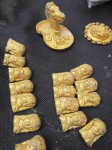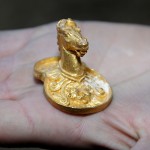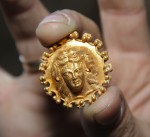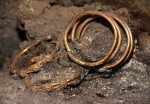 Archaeologists excavating a tomb in a Thracian burial complex about 250 miles northeast of Sofia, Bulgaria have unearthed a collection of beautifully worked gold artifacts. The pieces date to the end of the 4th or the beginning of the 3rd century B.C. and include four bracelets decorated with snake heads, a tiara or necklace decorated with lions and fantasy animals, 44 small gold busts of women which could have been horse trappings or clothing accessories, 100 gold buttons, a large gold ring or brooch with a female face in high relief and an incredibly life-like miniature golden horse head that once decorated the end of a bit.
Archaeologists excavating a tomb in a Thracian burial complex about 250 miles northeast of Sofia, Bulgaria have unearthed a collection of beautifully worked gold artifacts. The pieces date to the end of the 4th or the beginning of the 3rd century B.C. and include four bracelets decorated with snake heads, a tiara or necklace decorated with lions and fantasy animals, 44 small gold busts of women which could have been horse trappings or clothing accessories, 100 gold buttons, a large gold ring or brooch with a female face in high relief and an incredibly life-like miniature golden horse head that once decorated the end of a bit.
 The high quality of workmanship indicates that these were adornments of the elite, and indeed the tomb in which this treasure was discovered is the largest out of the 150 tombs in the complex near the village of Sveshtari. The complex was built by the Getae people, a Thracian tribe of warrior horsemen who inhabited the Lower Danube region in areas now part of Romania and Bulgaria. They initially used their famed cavalry skills in the service of other Thracian kingdoms, but by the late 4th century had splintered into principalities of their own.
The high quality of workmanship indicates that these were adornments of the elite, and indeed the tomb in which this treasure was discovered is the largest out of the 150 tombs in the complex near the village of Sveshtari. The complex was built by the Getae people, a Thracian tribe of warrior horsemen who inhabited the Lower Danube region in areas now part of Romania and Bulgaria. They initially used their famed cavalry skills in the service of other Thracian kingdoms, but by the late 4th century had splintered into principalities of their own.
 The Getic kings had access to the gold deposits at the mouth of the Danube, one of the largest sources of gold in ancient Europe. As early as the 7th century B.C., the Getae traded with the Greek colonies on the western shores of the Black Sea, and later with the Macedonians to the southwest of them and the Scythians north of the Danube. The style of the gold work discovered in the tomb reflects this variety of cultural influences from the peak of Getic rule in the area.
The Getic kings had access to the gold deposits at the mouth of the Danube, one of the largest sources of gold in ancient Europe. As early as the 7th century B.C., the Getae traded with the Greek colonies on the western shores of the Black Sea, and later with the Macedonians to the southwest of them and the Scythians north of the Danube. The style of the gold work discovered in the tomb reflects this variety of cultural influences from the peak of Getic rule in the area.
 Diana Gergova, head of the excavation team, thinks the size of the tomb and the richness of its contents suggest a connection to one of the earliest Getic princes.
Diana Gergova, head of the excavation team, thinks the size of the tomb and the richness of its contents suggest a connection to one of the earliest Getic princes.
“From what we see up to now, the tomb may be linked with the first known Getic ruler Cothelas,” said Gergova, a renowned researcher of Thracian culture with the Sofia-based National Archaeology Institute.
 Cothelas is known for having struck a treaty with King Philip II of Macedon in 341 B.C. while the latter was fighting the Balkan peoples to the west of Thrace. He became Philip’s vassal and sealed the deal by marrying his daughter Meda to the Macedonian king. She was his fifth wife, coming six years after his marriage to his fourth wife, Olympias, mother of Alexander the Great. When Philip died in 336 B.C., Meda committed ritual suicide to accompany him to the afterlife, a gesture that was not Greek or Macedonian practice and thus secured her a place in Philip’s tomb at Vergina.
Cothelas is known for having struck a treaty with King Philip II of Macedon in 341 B.C. while the latter was fighting the Balkan peoples to the west of Thrace. He became Philip’s vassal and sealed the deal by marrying his daughter Meda to the Macedonian king. She was his fifth wife, coming six years after his marriage to his fourth wife, Olympias, mother of Alexander the Great. When Philip died in 336 B.C., Meda committed ritual suicide to accompany him to the afterlife, a gesture that was not Greek or Macedonian practice and thus secured her a place in Philip’s tomb at Vergina.
According to ancient sources like Strabo’s Geography, Book VII, Chapter 3, the Getae worshiped their rulers, which might explain why Meda killed herself when her king and consort died. The military and political king would take on as co-ruler a religious leader with divination abilities who would then give his divine imprimatur to the king’s decisions.
 The find is also remarkable in its survival in context. Thracian gold has been a consistent lure for looters from its time of burial to the present. Most of the tombs in the Sveshtari complex were looted in antiquity, and Bulgaria’s cultural patrimony has been devastated by a massive increase in looting since the fall of the Iron Curtain in 1989. The Getae tried to keep their tombs safe from robbers by building vast networks of underground burials with no decoration or construction whatsoever above ground. This tomb appears to have been hidden with particular thoroughness.
The find is also remarkable in its survival in context. Thracian gold has been a consistent lure for looters from its time of burial to the present. Most of the tombs in the Sveshtari complex were looted in antiquity, and Bulgaria’s cultural patrimony has been devastated by a massive increase in looting since the fall of the Iron Curtain in 1989. The Getae tried to keep their tombs safe from robbers by building vast networks of underground burials with no decoration or construction whatsoever above ground. This tomb appears to have been hidden with particular thoroughness.
 Another tomb from the Sveshtari complex has garnered fame and a place on the UNESCO World Heritage List for its one-of-a-kind decoration: a chorus line of ten caryatids that are half human and half plant. Though clearly inspired by the caryatids who supported some of the most famous temples in the Hellenist tradition, these ladies with their inverted palmette chitons were a new Thracian design and entirely unique.
Another tomb from the Sveshtari complex has garnered fame and a place on the UNESCO World Heritage List for its one-of-a-kind decoration: a chorus line of ten caryatids that are half human and half plant. Though clearly inspired by the caryatids who supported some of the most famous temples in the Hellenist tradition, these ladies with their inverted palmette chitons were a new Thracian design and entirely unique.
Dating to the mid-3rd century B.C., the tomb’s archaeological wealth also provides material support for the ancient writers’ claims that the Getae worshiped their kings. Above the caryatids is a relief depicting a goddess presenting the horseback ruler with a gold wreath while processions of servants on either side carry offerings. A mural again shows the ruler on horseback, heading toward a god who is holding out a laurel wreath for him. The skeletal remains of horses inside the tomb indicate the king’s mounts were ritually sacrificed to carry him once again on the other side.